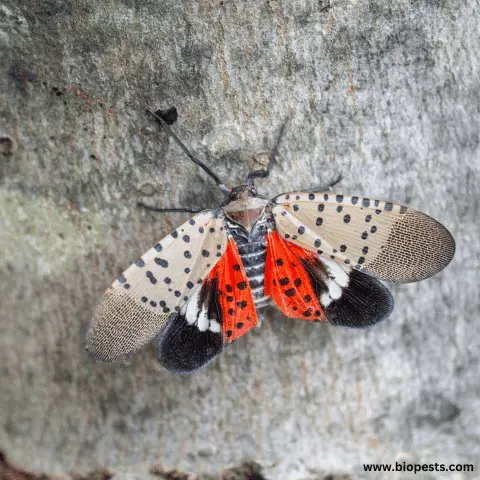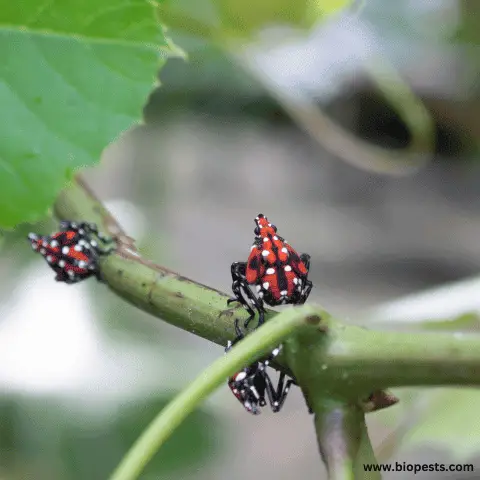If you live in the United States, there’s a high chance you might have heard of the Chinese lanternfly, also known as the Spotted Lanternfly. These insects are known for being destructive pests that feed on sap from fruit trees and plants, leaving crops withered and dead. Chinese lanternflies have become a global concern due to their rapid multiplication and the speed at which they spread. In this blog post, we will explore the impact of Chinese lanternflies on crops and plants, their life cycle, and ways to prevent their infestation
Where Does the Chinese lanternfly come from?
The Chinese lanternfly, also known as Lycorma delicatula, is native to Asia, specifically China, Vietnam, and India. This insect belongs to the Fulgoridae family, which includes more than 900 species of plant-hopping insects. What makes this pest so unique is its striking appearance. The lanternfly adults have a black, white, and red-spotted wingspan of 1.5 inches. Their underwings sport vibrant red and black stripes alongside a white band with black spots that resemble a lantern. Hence, the lanternfly was aptly named.

Lanternflies aren’t just pretty, though – they’re quite notorious for their insatiable appetite for trees and crops. The pest is known to feed on over 70 plant species, including fruits, vegetables, ornamental trees, and hardwood trees such as maples and oaks. However, its favorite hosts are grapevines and hops used to make beer. When the lanternfly feeds on these plants, it pierces the bark with its mouthpiece and sucks up the sap, which can weaken or kill the host plant.
The Chinese lanternfly was first discovered in Pennsylvania in 2014, believed to have arrived in the United States via shipping containers from China. Since then, it has spread across Pennsylvania, Delaware, New Jersey, Maryland, Virginia, and West Virginia, causing damage to trees, crops, and vineyards in its wake. The United States Department of Agriculture (USDA) has classified lanternflies as invasive pests .
The Life Cycle of a Chinese Lanternfly
The life cycle of a Chinese lanternfly consists of three stages: egg, nymph and adult.

- Egg Stage
The cycle starts with the spotted lanternfly laying egg masses on almost any surface it can find, including trees, rocks, cars, and outdoor furniture. The egg masses can contain up to 50 eggs and appear like a slime mold or hardened mud. These eggs usually hatch in late Spring when the temperatures start to warm up, although they are capable of hatching in cooler weather. - Nymph Stage
After hatching, the spotted lanternfly enters its nymph stage. As nymphs, they are wingless and require feeding daily. They are typically black with white spots and red patches followed by bright red and black pupae earlier on in their development. The nymph stage lasts anywhere from 30 to 50 days, depending on the temperatures and food availability. - Adult Stage
Once the nymphs have gone through several molts, they become adults that are much more mobile and active. During the adult stage, they develop wings, which allows them to fly long distances. The adult spotted lanternfly has colorful, off-white wings with black spots and bright red underwings. - Mating and Reproduction
As the adult spotted lanternfly reaches maturity, it begins to mate and lay eggs. This process usually happens during the late summer and early fall. Females can lay between one hundred to two hundred eggs per season, and usually choose previous egg-laying spots as new laying locations. - Overwintering
As winter approaches, spotted lanternfly adults and nymphs start searching for shelter in order to survive the winter. They hide in groups under the bark of trees, in cracks and crevices of the tree trunks, and any suitable location.
5 Natural Ways To Get Rid of The Chinese Lanternfly
The Lanternfly is a pest that has been identified as invasive in the United States with significant economic and environmental impacts. While the use of harmful chemicals like pesticides and insecticides have been effective in containing its infestations, it has also raised concerns and risks to the environmental and human health. So, here we are discussing some of the alternative solutions for managing Chinese Lanternfly infestations without harmful chemicals.
Sticky Bands
Sticky bands or sticky tape are very effective against lanternfly infestation. They look like glue-based bands and are wrapped around tree trunks to prevent the movement of the insects up to the tree. They work by trapping the pests as they try to climb up the tree trunk, preventing the insects from laying eggs. These bands are cheap, easy to install, and effective. The bands should be changed every 2-3 weeks and disposed of properly.
Manual Control
Physical removal is a simple manual solution that can be effective in reducing the life cycle of the Chinese Lanternfly. Removing the older nymphs and adult lanternflies could help to decrease the number of breeding adults. You can use a vacuum cleaner, a handheld bug catcher, or even a tree trimmer pole to reach high spots. Place the insects in a soapy water solution or freeze the captured insects to kill them.
Tree Covers
Tree covers, mosquito nets, or even stockings can be helpful in preventing Chinese lanternflies from laying eggs in the trees. You should securely tie the cover around the tree trunks and attach it firmly with string or clips. Also, It is essential to keep the covers well maintained and clear of any debris or water that could make it easy for the insects to lay eggs.
Destroyed Host Plants
Lanternflies are attracted to highly productive plants. By destroying the host plant where lanternflies lay eggs, the infestation can be prevented from the egg stage itself. Such plants include grape vines, apples, stone fruits, and other deciduous trees. Destroying the host plants has been successful in reducing the infestation of the insects.
Encourage Natural Predators
Birds, spiders, and some insects like ladybugs or praying mantis are natural predators of the Chinese Lanternfly and can be encouraged to help in controlling the infestations. You can avoid the use of harmful pesticides to create a healthy environment for natural predators to thrive. Planting specific vegetation and flowers that attract natural predators could help control the infestations without harming the organic environment.

5 Effective Ways To Prevent Infestation of Chinese Lanternfly
Prevention is always better than the cure.
Spotted lanternflies can wreak havoc on crops, trees, and plants and are also destructive to homes and property. Their presence can impact not only the economy but also the environment, which is why it is crucial to take measures to prevent their infestation.
Here are 5 effective ways to prevent the infestation of Chinese lanternflies.
Remove Egg Masses
One of the most straightforward ways to prevent the infestation of Chinese lanternflies is by removing their egg masses. Lanternflies lay their eggs on any surface, such as trees, rocks, and outdoor furniture. You can easily remove egg masses by scraping them using a putty knife or plastic card. Make sure to dispose of them by placing them in a plastic bag, sealing it, and throwing it in the trash.

Insecticides and Systemic Tree Injections
Another effective way to prevent Chinese lanternflies is by using insecticides and systemic tree injections. You can employ the use of chemical controls, such as insecticides, to kill adult lanternflies. Systemic tree injections can kill lanternflies by poisoning them when they try to feed on the tree or plant. These treatments are effective and best done by licensed professionals.
Use Sticky Bands
Sticky bands are a non-toxic way to protect your trees and plants from infestation. They work by trapping the insects as they crawl up the tree by sticking to their legs. Sticky bands should be wrapped around the trunk and attached using a clip. Make sure to place them before the active period of lanternflies, which is around May to November, and replace them every two weeks or as needed.
Plant Trap Crops
Planting trap crops can also prevent Chinese lanternflies infestation on your property. Trap crops are planted as a decoy, which will attract the lanternflies, and they will feed on these instead of your trees and plants. Furthermore, these trap crops can also help reduce the need for insecticides and are also beneficial for soil and pollinators. Good trap crops include sunflowers, calendula, and buckwheat.
Clean Up Your Property
Cleaning up your property is crucial to prevent Chinese lanternflies. Lanternflies are attracted to cluttered and messy areas. Ensure that you regularly clean your property and remove debris, such as woodpiles, weeds, and excess branches. Also, make sure your gutters are clean as they can provide an ideal spot for lanternflies.
Conclusion
The Chinese lanternfly might seem like a pretty insect, but it causes severe massive damage to trees, crops, and the economy. Ensure to always monitor your trees and plants during the different seasons, to stay ahead of the spotted lanternfly. It’s essential to be aware of the lanternfly’s biology, food preferences, and impact to prevent its massive spread. If you see a lanternfly, take action, inform your local authorities, and report the sighting to the USDA. Through continuing research and concerted efforts, we can hope to control the spread of this exotic pest.
Some of the links above are affiliate links, meaning at no additional cost to you, I will earn a commission if you click through and make a purchase.

